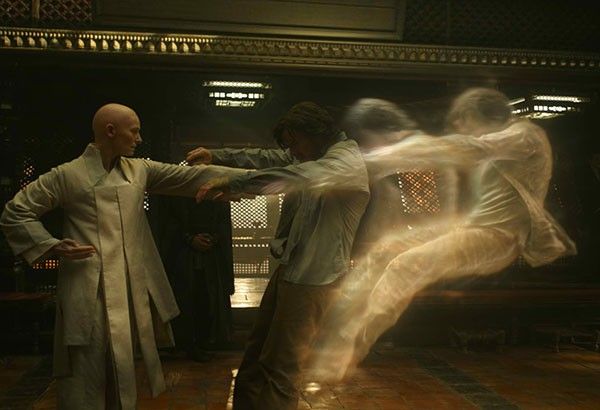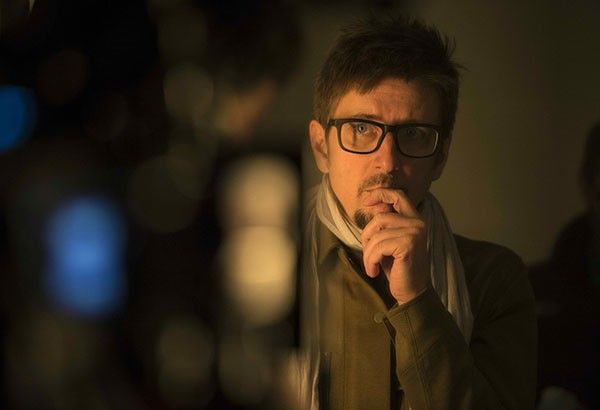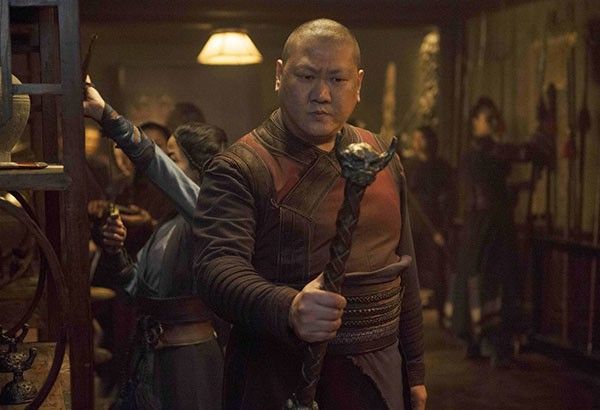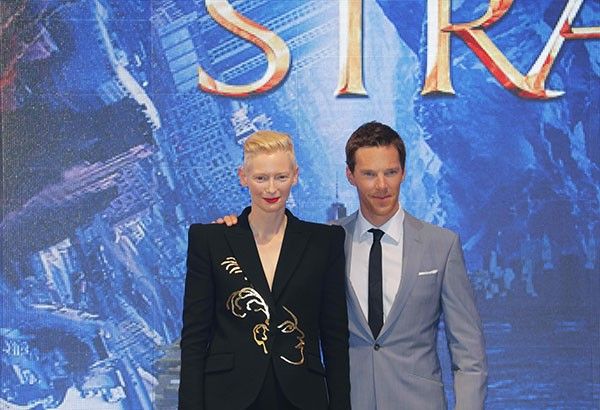Spellbound by ‘Doctor Strange’s’ Tilda Swinton and Scott Derrickson

When talking about Marvel Studios’ upcoming movie Doctor Strange, the biggest issue is less about superheroes and more about stereotypes. The Benedict Cumberbatch-starring film about an accomplished and arrogant surgeon who, after a tragic accident — and stop me if you’ve heard this one before — learns magic to reinvent himself, has gotten its fair share of controversy and accusations of whitewashing and depriving roles to minorities. In the center of it all is The Ancient One, the wise master of magic played by the constantly shape-shifting Tilda Swinton — but who in the original comics is an old bearded Asian man who teaches the inexperienced Stephen Strange about the mystic arts. Months after Swinton was cast, critics and fans alike rose up and accused Marvel Studios, director Scott Derrickson, and Swinton herself of washing a traditionally Asian role white.
On the eve of Doctor Strange’s release, Swinton and Derrickson sat down for a roundtable discussion about the controversy, the steps they took to promote diversity, and the business of changing stereotypes.
PHILIPPINE STAR: Taking our cue from the film, we’d like to ask: what’s the strangest thing about each of you?
TILDA SWINTON: I’ll tell you the strangest thing about me — I don’t think (Scott) knows this about me, and this is a superpower — I can find things. If anyone in my house loses something, they come to me and go, “I’ve lost my phone! I’ve lost my keys!” And I find them. I don’t know how I do it really.
SCOTT DERRICKSON: That’s extraordinary! I don’t know how I can answer that question after hers.
TS: It’s very, very odd, I don’t know why. It happens very often and in fact the people most familiar with me tend to rely on it. I have an agent who’s delightful and very capable, and he travels with me and looks after me. He occasionally hides his passport somewhere and I have to find it.
SD: If I’m being honest, like many directors I’m pretty O.C.D. — and you kind of have to be, to do this job — but the strangest thing about me is how abstractly I think about meaning, and why we’re here, and the big philosophical questions. I studied philosophy as a student and my brain is usually there. I try to ignore it and live a practical life in spite of it, because I can just as easily disappear into books.
TS: But you channel it into your work and that’s for the benefit of all of us. We’re very grateful.
Speaking about the work and your role in Doctor Strange, how did you reinterpret The Ancient One?
TS: The Ancient One in the comics is male and is visibly ancient, whereas I am just ancient. (Laughs) He is also of Asian origin and has a long beard. What was important was to find the common denominator between us, so we started with the idea of perspective. Someone who’s lived that long and someone who’s seen as much as The Ancient One has, has a perspective which, in my interpretation, leads to a sense of relaxation and an absolute lightness of touch. There’s nothing heavy at all about The Ancient One. And that was really the starting point and in a way the ending as well.
SD: The first decision I made was really to tackle the stereotype of that character and make The Ancient One a woman. And I’ve received a fair amount of criticism because I didn’t cast an Asian woman, but every time I tried to work on the scripts and write it for an Asian actress, I was writing a dragon lady. I’ve read plenty of people saying that there’s a way to get around that, but I just couldn’t find it. The bottom line is, what I had to keep from the comics was that this was going to be a magical, mystical, marital arts mentor.
The reason why I wanted a woman specifically as a mentor was, first, it was The Ancient One — I wasn’t going to cast somebody young — and because where do you see women of Tilda’s age in big tent-pole movies? Where are they? It was really that. I think diversity is the responsibility of directors. It’s the responsibility of studios, producers, and directors. I take that responsibility very seriously and I wanted to bring in this movie a tapestry of diversity that was unique to a tent-pole movie, unique to even a Marvel movie. What we were missing (from all these movies) was a female that wasn’t in her twenties, wearing tight leather, looking like a fanboy dream girl. I wanted something else. That was why (I did it) and also to get away from the cliché of the old male mentor to the male lead. Again, just try and subvert rather than play into clichés and stereotypes.
That insight leads us to the character of Wong, who in the comics was Doctor Strange’s Asian manservant, but you’ve given him a new role and purpose for this movie.
SD: Here’s the thing with that character. Unlike The Ancient One, Wong is a character I can totally reinvent. I was working on The Ancient One first and Wong wasn’t existent in the script at that time because when I looked at those two characters I was like, these are both pretty offensive stereotypes and Wong was basically a martial arts manservant. What am I supposed to do with that character? At first I thought he just wasn’t going to be in the movie. But then I was never comfortable with the idea of erasing an Asian character from the adaptation, and I’m still not comfortable with that, to be honest. Ultimately it felt like (recasting The Ancient One as a Celtic woman) was the lesser evil but once I did that, I knew I had to bring Wong back. To my delight — and I think I was a little late to discover this — I could completely subvert and invert Wong. So instead of a manservant, Wong is now a master of the mystic arts. Instead of a sidekick, he’s a librarian and intellectual mentor to Stephen Strange. So I kind of took everything he was in the comics, and flipped it, and expanded that into a pretty sizeable role in the movie. We do test screen runs of these kinds of films, and Wong is a great character and audiences will feel well represented. I’m really just proud of this character and I think (actor) Benedict Wong’s just amazing in it.
So Wong wasn’t just there to alleviate the controversy surrounding the casting of The Ancient One?
SD: I’m going to say something odd, since we’re going so deep into this topic. I’m going to defend those critics. I think those critics who are very vocal and attacked our film weren’t wrong. Hollywood representation of Asians and Asian-Americans is woeful. It always has been. They’re either non-existent or racial stereotypes. That is the history of Asian representation in American cinema. It’s terrible. It’s just terrible. I think the voices on this issue, I think they need to attack the way they (do). They have to attack with anger, with hostility, because that’s the only way people pay attention. I don’t discredit and I certainly wouldn’t be one to silence those voices. They have to keep saying what they’re saying in order for things to change. I just know that in this particular instance, what they don’t know is how serious we took these issues and how devoted I was in making the best possible choices.
Moving on to a lighter topic, you’ve mentioned Doctor Strange co-creator Steve Ditko’s art as a big inspiration for the film’s aesthetic. Apart from Ditko, were there other things that inspired the look of Doctor Strange?
SD: Not so much film inspirations. I mean people have talked about Inception, (with) one sequence that draws from it, but again, that movie was seven years ago, and when I looked at it again, and I think (what they did) was the tip of a very visual effects iceberg. And I was interested in the iceberg. (Laughs) That’s a single sequence. It’s the same way Christopher Nolan paid homage to On Her Majesty’s Secret Service in Inception’s snowmobile and gunfight scene. Certainly artworks (were an influence) like M.C. Escher and Salvador Dali. A lot of surrealist photography as well and I think the biggest mental influence on me was psychedelic rock from the late ’60s. That’s all I listened to for a year. I went into a deep rabbit hole.
TS: But you know (what) a film that Doctor Strange really reminds me of — and I think I’ve mentioned this to you before, and I don’t think it’s an active source, but it’s really close to one of my favorite films — is Michael Powell and Emeric Pressburger’s A Matter of Life and Death.
SD: That’s such a great film. There’s no film like that and if you haven’t seen it, you have to see it.
TS: That film has a very important operating room moment where the character pops up outside of his body and goes somewhere else to have a conversation.
SD: That’s the way influence works. Subconsciously, you know? Gaspar Noé’s Enter the Void was certainly something I looked at again, just because I can’t think of another one offhand that would be more inspiring, (with) that kind of hallucinogenic, psychedelic ambition. But in the end, it’s all swirling around in you and what you don’t want to do is take a specific painting or song, certainly not another film, and then try to replicate that but better. If you do that, you’re going to fail. You have to take all of it in and swirl it around like a soup inside of you and then bring your best imaginative game to the table and see what comes out. That’s how we made this movie.




* * *
Doctor Strange opens in cinemas Oct. 26.















